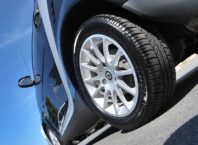There might be more differences in a cheap tire compared to a more expensive one than you think. Tires are more than just a piece of rubber. Advanced engineering and a lot of work go into manufacturing premium, high-performance tires. From the kinds of rubber used to how the tire is designed, every single tire produced is a result of hours of research and development and a more expensive tire will give significantly better performance under a wider variety of road and weather conditions.
Such premium tires are often safer to drive with than cheaper ones. They go through rounds of testing to ensure that your car’s handling and braking are in their best condition, regardless of the road conditions. Moreover, premium tires often come with other benefits such as less noise, longer tread life warranty, and mileage. Even though these benefits come at a price, it will help to improve your whole driving experience in the most basic but important aspects.
Other than quality, there are other factors that play a role in determining the cost of a tire. Knowing how each of these can affect tire prices can come in handy the next time you decide to purchase a set of new tires. You can find more information here about tires, including the safest and most durable tires.
Contents [show]
Durability
This is a good test to determine if the tire you are getting is worth the investment or not. The more durable the tire, the longer it will last and the more money you save as you do not have to purchase a new one so often. To discern whether a tire is durable or not, the hardness of the rubber matters. A higher-performing tire has softer rubber but this also means that they would wear out faster, and vice versa. You could also opt for tires that have been reinforced to have longer-lasting side walls but this is not observable to the eye and you would have to inquire more with your car salesperson or do your own research beforehand.
Handling
With better handling comes a better grip that your tires have on the road and this is something that you probably would not want to skimp on. This makes it safer to drive in harsher conditions, such as when it rains or snows, or even at high speeds. Having a tire with good handling also makes it easier to turn and this would allow you to react more swiftly, should any emergencies arise while on the road.
Tread
Essentially, tires with a thicker tread and wider grooves provide more friction and make handling better in harsher weather and road conditions. However, this means that the tires would be relatively noisier, which could be a concern to some. Hence, it is important to choose a tire with a tread that best meets your needs. Thicker treads may cost more but it is often not a very crucial factor that influences the cost.
Braking Distance
Shorter braking distances are usually preferred as it allows you to react more readily to obstacles on the road and even emergencies. Hence, this usually translates to a higher price but this is normally just one of the outcomes of a tire’s design.
Comfort
A combination of a variety of factors comes together to give a more comfortable and smoother driving experience and these are more likely to be provided for with higher-performing tires. Needless to say, such tires come at a higher price.
Drag
The lesser the drag, the easier it is for your car as it uses up less fuel, costing less in terms of car maintenance in the long term. However, such tires are often intricately designed and therefore would be more costly.
Brand
As with other products, a tire that is of a more popular brand usually carries a higher price. This is because you would also partly be paying for the reputation and credibility of these tires so that you know that you are going to get a tire of good quality and is long-lasting.
Noise
While noise alone cannot really indicate the quality of a tire as it is also affected by the tread, more premium tires are often made with more rubber and are specially designed to reduce noise levels while driving.
Conclusion
Today, the manufacturing of tires is a global industry. However, it is still key to look out for where the tires are being produced as different countries follow different industrial guidelines and have different production facilities. For example, some of the newer Chinese companies like Westfield and AKS are infamously known for having cheap tires that lack quality control and warranties. In general, tire quality is mainly determined by the market segment and it usually costs more for higher quality tires. So, don’t skimp on tires as you may also be skimping on the quality and safety of your driving experience.
Furthermore, tires experience wear and tear over time, making regular maintenance important. While not commonly seen, there are instances whereby the tire wears out faster than expected. Hence, it is also important to purchase tires from a trustable manufacturer so that you would have access to a tire warranty, insuring you against the potential of having to fork out a large sum of money to replace your tires. Purchasing of additional warranty coverage is even possible in some cases.
Tread life warranty is one of the most common ones there are and it should be noted that these warranties work only if you do not mistreat your tires by following its maintenance guidelines.
Lastly, a road hazard warranty is also often bought by drivers, that insures them against any damage to the tires while driving. Such damages include hitting debris on the road. Generally, such warranties are offered by the shop that installed the tires themselves and is an additional fee that drivers must pay to insure themselves. Some companies like Continental and Bridgestone do offer such a warranty for some of their products but do not that these warranties usually only cover the tire’s first year and it can be quite limited.












